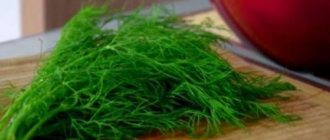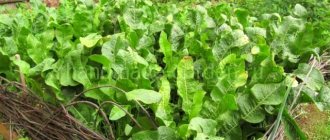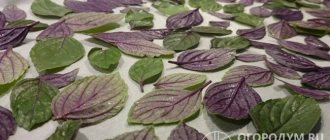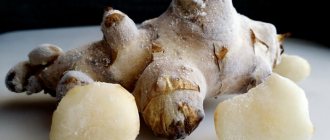This vegetable resembles a sunflower with its flowers, ginger with its roots, and often tastes like potatoes, and is also called “earthen pear” or “Jerusalem root.” In a word, such a rich combination of properties and qualities, combined into a single whole, is what makes Jerusalem artichoke, on the one hand, not very common, and on the other, a simple and unpretentious root vegetable.
Jerusalem artichoke is absolutely not difficult to plant, but when it comes to storing it, questions arise. How and when to collect this miracle of nature, and most importantly, how to preserve it longer, will be discussed.
Jerusalem artichoke: when to dig?
- Experienced gardeners say that it is not worth harvesting the entire crop at once. At the beginning of autumn, you can collect what is already fully ripe and can be consumed immediately. The fact is that Jerusalem artichoke is frost-resistant and is perfectly preserved in the ground, so it can survive frost (and it can withstand even -40°C if covered with grass or leaves, snow or soil) even while remaining in the soil. At the same time, preserving a plant in a cellar is often problematic.
- And yet, if for some reason it is unacceptable for you to leave root crops in the ground, dig them up already in late autumn, somewhere closer to November. The longer the Jerusalem artichoke stays in the ground, the more benefits it will have.
Jerusalem artichoke health benefits
- And vice versa, if dug up in early autumn, it will not have time to accumulate many useful substances in which it is so rich. The best time to harvest is dry weather. Slush, and especially frozen slush, will significantly complicate the work.
- An approximate scheme for harvesting Jerusalem artichoke is as follows. In September-October, you need to dig up tubers as needed. When late autumn arrives, collect part of the root crops for one and a half to two months in order to eat and, if there is livestock, for their feed.
- By the way, if you cultivate Jerusalem artichoke specifically as a fodder crop, then you don’t have to collect it at all - just release the pigs onto the plot, and they will dig the tubers themselves. Then - in winter and early spring - you can use the tubers that have remained overwintered in the ground - they are full of vitamins.
Where to buy Jerusalem artichoke
Jerusalem artichoke here is more of a gastronomic exotic than a familiar product, so you cannot buy it in the vegetable department of the nearest thrift store. However, Jerusalem artichoke is available for sale, and if you set your mind, it is not so difficult to find it, especially during the tuber digging season. Where can I buy Jerusalem artichoke?
- Stores with eco- and organic products. The beneficial properties of Jerusalem artichoke have long attracted the attention of advocates of a healthy lifestyle.
- Vegetable rows of food markets, farmer's fairs.
- Private message boards on the Internet (for example, Avito). Through them, private farm owners often sell surplus crops.
- Hypermarkets, premium grocery stores.
But the best thing, of course, is to simply grow Jerusalem artichokes in your dacha. Planting material can be purchased either from private traders at the already mentioned online flea markets, or you can contact the supplier by asking a question on some popular gardening forum.
When to collect Jerusalem artichoke in spring?
- That part of the crop that remains in the ground until spring must be collected before the earth begins to warm up, otherwise the Jerusalem artichoke will begin to germinate, and its benefits and nutritional value will significantly decrease.
- There is another danger of untimely spring harvesting - this is the possibility that the root crops will be damaged by rodent pests. Therefore, before the onset of constant warm average daily temperatures, the crop must be fully harvested.
Jerusalem artichoke - calorie content per 100 g, who is useful
The importance of timely harvesting
The maximum benefit and best taste of the tubers are achieved if they were dug up at the right time. Untimely harvesting worsens the taste and reduces the nutritional value of tubers (we talked about the BJU, calorie content and chemical composition of this vegetable here). If tubers are dug before their ripening period, then some of the nutrients will remain in the greenery of the plant. Late harvesting does not threaten the tubers, but the above-ground part withers and dries out, losing its feeding qualities.
Jerusalem artichoke: how to dig?
- When you decide on the date for digging up the tubers, cut the shoots approximately 10 days in advance , leaving about 20 cm above ground level. So the Jerusalem artichoke will ripen a little more - and you can take up the shovel. The root crop is dug in the same way as potatoes - the bayonet of the shovel is driven deep and pries up the tubers, digging them up. a fork with a not very wide distance between the teeth for digging
- Just like potatoes, Jerusalem artichokes are placed in buckets or boxes and taken to the cellar for storage or home - depending on how you plan to store the root crops. If the tubers are wet, you should not place them in the cellar without drying them. But you absolutely can’t wash them!
- If you decide to leave a few bushes to dig them up in the spring when the soil warms up, then create a protective layer of hay for them or do not cut such bushes along with the rest.
Digging
Healing recipes from Jerusalem artichoke leaves
Jerusalem artichoke leaf tea
Place 1 tbsp in a thermos. a spoonful of crushed leaves (fresh or dry - it doesn’t matter), pour 500 ml of boiling water. After 3 hours, the healthy drink is ready.
How to use. Drink 100 g 20 minutes before meals, no more than 3 times a day.
What does it help with? Strengthens the immune system, improves brain function, helps with constipation.
Jerusalem artichoke tincture
Pour 500 g of dry leaves into 1 liter of vodka and leave in a cool, dry place for 15 days.
How to use. 1 tbsp. Dilute a spoonful of tincture in 150 ml of water. Take 3 times a day.
What does it help with? Cleanses the liver, removes waste and toxins from the body.
Bath infusion
Pour 3 liters of boiling water over 10–15 Jerusalem artichoke leaves and leave for 30 minutes. Strain and pour into a bath of warm water.
How to use. Take a bath for no more than 10 minutes.
What does it help with? Joint pain, radiculitis, gout.
How to store Jerusalem artichoke?
- Storing Jerusalem artichoke in winter is a very problematic task, since it tends to deteriorate very quickly - a few days at room temperature are enough for the tuber to wilt and become unfit for consumption.
- Therefore, you need to store Jerusalem artichoke roots in the cold, for which you use options such as a freezer, refrigerator, basement, balcony.
- In addition, Jerusalem artichoke can be stored in piles, which are essentially shallow pits. Root vegetables are poured into them, alternating their layers with layers of sand or straw, and sometimes even snow is used. And the option described above is to simply leave the tubers in the ground, where they can be stored until the onset of heat, and you can dig them up as needed, if the condition of the soil allows.
Storing root vegetables
How to store Jerusalem artichoke in the cellar in winter?
- The cellar should be humid, and the higher the humidity, the better for the preservation of the tubers. Ideally it should be at least 90% . A fairly low temperature is also required - no higher than 0°C.
- Root vegetables are sprinkled with earth (you can also use wet sand) and placed in spacious boxes, preferably wooden rather than plastic.
- Capacious bags are also suitable, again, made of natural burlap, and not made of cellophane. In this form, Jerusalem artichoke can be stored for several months. In the same way, you can store root vegetables on the balcony.
How to store Jerusalem artichoke in the refrigerator?
- This is a short-term storage option, approximately 2 weeks. The main thing is to choose a container that would provide the tubers with the necessary humidity and inaccessibility of air.
- This can be a closed container, a plastic bag, or any other container that provides the necessary conditions. As a last resort, you can even simply wrap the Jerusalem artichoke in a damp cloth and put it in the bottom drawer. This way you can briefly store a small amount of Jerusalem artichoke, which you plan to use in the near future.
Step-by-step instructions for the procedure
- Inventory. You will need: a pitchfork or shovel, a container for storing and carrying root vegetables, gloves.
- Time of day and weather . Try to harvest in the early morning or evening, on a cloudy but not rainy day.
- Digging process . When digging, you need to be careful and try not to damage the tubers; if possible, remove and clean them with your hands without tapping them against each other. After harvesting, the tubers should be placed in a dark, cool, well-ventilated place.
- Initial preparation for storage. When storing in a cellar, basement or pantry, place the root vegetables in a box with damp sand, which is then transferred to a place of permanent storage.
AdviceIf you plan to store it in the refrigerator, put the root vegetables in plastic bags, ideally in vacuum bags. If this is not possible, try to keep as little air in the bag as possible and keep it tightly sealed.
How to freeze Jerusalem artichoke?
- Jerusalem artichoke can be frozen in the same way as other vegetables. The tubers must be cleaned , washed thoroughly and dried. Grind the way you intend to use it: cut into pieces or grate, you can do both.
- Some housewives use a 10-minute blanching in whey from milk and cottage cheese before freezing . Then place in portions in plastic bags or containers and store in the freezer. Defrost slowly by placing in cold water.
The use of Jerusalem artichoke in medicine
First of all, Jerusalem artichoke will be useful for people with diabetes. The inulin it contains is a natural analogue of insulin. By regularly eating tubers, you can reduce your sugar levels. Ekaterina Golubovskaya notes that inulin may also be useful for glucose metabolism:
“Some studies show that inulin helps lower fasting blood sugar and lower fasting insulin levels in people with type 2 diabetes,” says the expert. Also, people suffering from intestinal dysbiosis, obesity, high blood pressure and blood cholesterol levels should pay attention to Jerusalem artichoke.
Jerusalem artichoke leaves are used in folk medicine in the treatment of joint diseases, osteochondrosis, polyarthritis, and heel spurs in the form of decoctions for hot baths.
How to dry Jerusalem artichoke?
- You can dry Jerusalem artichoke at home just like any other fruit. For example, outdoors, why cut the tubers into thin slices and lay them in one layer on a flat surface.
First, let's cut
- Needless to say, the fruit should be free of dents and damage. Take it outside and place it out of direct sun. And it is also necessary to protect the dryer from flies and midges, for which you can cover it with a layer of gauze on top.
- The next drying option is oven . To begin with, the tubers are boiled in salted water with a teaspoon of soda for about 10 minutes. Then filter and cool. After this, the Jerusalem artichoke should be laid out on a baking sheet or on a fine wire rack and kept for about three hours in an oven heated to 50°C, stirring occasionally.
- The third way is to use an electric dryer , placing the tubers on the racks and turning on the device for 4 hours. Place dried Jerusalem artichoke tubers in a container and place in a dry, unlit place - this way it will be stored for a year. Part of the dry product can be immediately ground in a coffee grinder - you will get a natural energy drink, which all you have to do is pour boiling water over it and, after it has steeped, drink it instead of coffee.
Useful properties of Jerusalem artichoke
Jerusalem artichoke tubers are rich in B vitamins, especially a lot of B1. It is useful for the nervous and digestive systems, maintaining heart function.
They also contain a lot of vitamin C, which is responsible for the normal functioning of the immune system.
Tubers also contain a lot of potassium, calcium and zinc. They are loaded with antioxidants. And, of course, Jerusalem artichoke contains a lot of fiber, which stimulates digestion.
Jerusalem artichoke flowers have the same healing properties as the leaves.
How to store Jerusalem artichoke leaves?
- To preserve the foliage for many months, it must be thoroughly dried. It is best to do this by placing them in the hottest room, which is also quite dry. Be sure to ensure that the leaves are not exposed to direct sunlight - this can contribute to the destruction of vitamins.
- Experts do not recommend using an electric dryer, because when drying, some of them crumble and fall through the grate, forming dust and debris.
- Dried leaves can be poured into a glass jar or other container and closed tightly. It’s even better to collect dry leaves in a linen bag and tie it tightly. Natural fabric will promote the “breathing” of inflorescences and leaves, from which, as well as from the tubers themselves, tea can be brewed.
Can make delicious tea
How to properly prepare a vegetable for digging?
Regardless of when you intend to dig up Jerusalem artichoke - in the fall or in the spring, the plant must be prepared for harvest. The above-ground, green part should be cut off no later than two to three weeks before digging up the root crops. But you shouldn’t rush into this either - then you risk not getting a noticeable share of the harvest, not allowing the “roots” to be nourished from the “tops”.
If the main purpose of growing Jerusalem artichoke is to obtain useful food for animals, harvesting should occur much earlier - until the stems and leaves begin to share their strength with the roots. The first ten days of July are perfect for this.
How to preserve Jerusalem artichoke for the winter?
- Jerusalem artichoke can be used in preservation - this is also one of the ways to preserve its properties and enjoy it in the winter.
- It enhances the taste of dishes, giving them a certain piquancy. The root vegetable is good in winter salads with vegetables; you can quickly make jam from it, jam with the addition of plums, or make a dessert by adding pumpkin and lemons.
- Jerusalem artichoke can be fermented and pickled - in a word, used in preservation in large quantities and in a variety of ways.
Jerusalem artichoke and others - friendship forever
From velvety purees to savory pies filled with wild mushrooms and tart green apples, Jerusalem artichoke is at home in many dishes. It goes well with the rich taste of forest game and is not at all out of place in delicate poultry and fish dishes. The tuber feels great in soups. On its basis, a good broth is brewed, which is good both in itself and as a base for sauces, since it is subtle and elegant in taste.
One of the simple and effective ways to bake Jerusalem artichoke is a mixture of olive and butter, rosemary and balsamic vinegar. And among vegetables, he is friends with carrots and celery.
In Germany and other European countries, the tuber is even used as a raw material for alcoholic beverages. It is widespread, cold-resistant and unpretentious. Tubers are rich in potentially fermentable carbohydrates. The yield of alcohol from Jerusalem artichoke is on average 1.5-3.5 times higher than from wheat or potatoes.
Cut Jerusalem artichoke into slices
How long does Jerusalem artichoke last?
- Tubers can be stored in the bottom drawer of the refrigerator for a maximum of a month, and more often – 2-3 weeks. If you freeze Jerusalem artichoke, the shelf life will be 2 months, in the basement - up to 2 months.
- Jerusalem artichoke left in the ground will be usable throughout the winter. In dried form, the shelf life is one to one and a half years.
Useful articles for gardeners:
- When to harvest onions
- How to properly care for bulbous flowers
- When to remove leeks from the garden for storage
- When to dig up gladioli in the fall for the winter after flowering
- When to dig up tulip bulbs after flowering
When is it collected in different regions of Russia?
In all regions of our country, Jerusalem artichoke is harvested at different times, depending on the climate and plant variety, as well as the purpose of cultivation. Read when to harvest in Kuban, Siberia, the Urals and other regions.
For food for people
In Siberia and the Urals, the climate is the most severe, which means harvesting begins earlier - tubers are dug up from mid-ripening plants in September, and a month earlier from early-ripening plants. Root crops of late-ripening varieties are harvested before the end of October, when the first frosts have passed.
In Central Russia, harvesting times roughly correspond to those in Siberia and the Urals, but in Kuban, harvesting begins much later - the weather permits. Root crops of late-ripening varieties can be stored in the ground almost until the new year. Early ripening varieties, which were planted in the ground in early spring, can be dug up in mid-summer, and mid-ripening varieties - in September.
For feeding livestock
Advice
The differences in harvesting Jerusalem artichoke for livestock feed are only in the use of the upper, green part of the plants; the root crops are harvested at the same time as for human food. The guideline for starting mowing is the tubers - their size should be no less than an acorn.
- In Siberia, you can mow Jerusalem artichokes of mid- and early-ripening varieties from mid-July to mid-August, and late-ripening varieties until early September.
- In the Urals, the timing is approximately the same as in the central part of Russia - haymaking begins from the beginning of July to the end of August. Moreover, you can have time to clean the greenery twice.
- In Kuban, you can mow the green part of late-ripening varieties of Jerusalem artichoke up to three times, until November.
The timing of harvesting the green part of the plant does not differ for early-ripening and mid-ripening ones - feed for livestock begins to be prepared in mid-summer.











